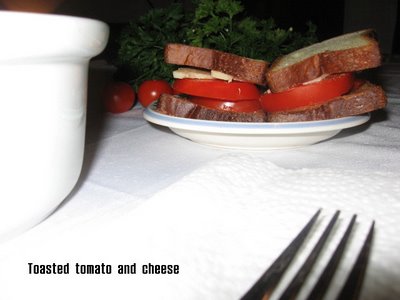20060630
Trout with caper-shallot garnish and potatoes in parsley + Parmesan celery salad


or, Pairing fish and other light meals with chilled-down reds
Earlier this week, warm and humid days built up my thirst for a nice light Loire red wine. From my wine rack, I found an Anjou Cabernet. I knew nothing about it except that it possessed the two keywords I was looking for: Loire and Rouge. I remember buying it on sale -- pretty much sight unseen -- for moments exactly like these when I would invariably want a fresh Cabernet Franc to sip alongside a light and summery meal like the air-poached filet of trout and boiled potatoes pictured above.
At the end of a hot day, a chilled aromatic red wine that is low in tannin is great at the dinnertable. It can be the perfect pairing. But my Domaine les Grandes Vignes L'Aubinaie 2003 packed a punch, and it was more than the aromatic wallop that a Loire red often delivers. This one certainly had some body and weight to it.
For sure, the sweltering 2003 vintage could've intensified the consistency of wine, giving it greater depth and brawn, and but this bottle was practically manhandling my demure trout filet. I was surprised that the Parmesan cheese, which I shaved sparingly into my salad because I thought its strong flavour would overpower the wine, ended up being the most natural match for what I was drinking. Why? Sure enough, upon closer inspection, the Cabernet variety listed on the back label was "Franc and/or Sauvignon". It was right there just above where it said "Serve lightly chilled" and then it became obvious.
Even though the recommended serving temperature was 12 to 14 degrees Celsius, this red was no light and merely perfumey expression. It was infused with Cabernet Sauvignon. Sometimes wine more lightweight than this needs chilling to be best appreciated. On this day I was glad to have something cool in my glass, even if the fullness of body didn't demand it. But in the end I think you could avoid the chilling for this wine. And next time I would pour it with steak.
Since I got the wine on a whim and likely will not have the chance to get more, there may not be a next time. It was such an interesting cuvée though, so I jotted down the following information from its many busy labels before I tossed it into the recycling:
- Domaine les Grandes Vignes is located in Layon in the Loire Valley
- The estate is family run by the Vaillant brothers: Laurence, Jean-François and Dominique
- The cuvée L'Aubinaie is certified as organic and earns the Terra Vitis designation
- Bottled at the Vaillant Estate "La Roche Aubry" Thouarcé, France. 13%.
Posted by Marcus | Friday, June 30, 2006 3 comments
20060629
Greek resinated wine to drink in the summertime: Malamatina
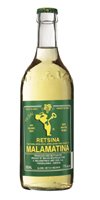
Retsina is a resinated wine and one of the few around these days. You see, resinated wine has along history. Primitive winemaking methods sought out pine resin as a solution. Apparently, resin-coated earthenware would render a porous container sealed. This would help store the wine that early vintners produced. Tastes grew more accepting of pine-laced wine coming out of the now-airtight jugs and it wasn't long until people figured out that adding resin to the wine itself would help even more in guarding wine's freshness.
And how! Today's resinated wine has the freshness of surgical tables and Pine Sol, but in the right conditions, it offers lovely refreshment value, no matter whether you are looking for nostalgia or tradition or not.
RETSINA RULE #1: DON'T FORCE IT -- WAIT FOR IT
I like to think that you need to be in the right mood to drink Retsina. Some people never are. In the summer I often am. Some Retsina is plonk, but good bottles, like Malamatina Retsina (shown linked above in its cute little 500mL format with its cute little yellow man socking back the Retsina so successfully that a wondrous giant key emerges to unlock his stomach) or Retsina Kourtaki are very enjoyable aperitifs, or so I find.
The Malamatina, whose name seems to strangely convey "you'll feel bad when morning comes" in some Latinate dialect, is nothing to fear at all. Bottom line: Like Malamatina's, any good glass of Retsina is light in colour, body and alcohol. It should pack zingy refreshment, not just because it is served very cold, but because the pungent resinated pine flavour is a real trip for your tastebuds.
RETSINA RULE #2: BE CAREFUL WHAT YOU SERVE IT WITH
My friend Alex Kapelos-Peters favours a little Retsina at the properly appointed moment. Last summer, Alex's mother, who is Greek, emailed us her suggestions for food pairings when she heard that we were about to open a bunch of different brands of Retsina. Ideas she sent us included olives, tomatoes, and other finger foods, especially fried foods, such as breaded fish, as the wine cuts the taste of the oil.
Yes I suppose they work. But to me nothing embraces the unique resinated tinge that pervades every wide-flaring V-shaped glass of Retsina as well as leftover pizza crusts. There's something about the yeasty quasi-doughiness about this bread -- some specifically Greek pita bread would suitably apply here -- and it matches perfectly with the strident and antiseptic nature of this wine. Try it! I urge you. If you want to dress it up a little, serve it with severely bland, medium-hard cheeses, like marbled cheddar or Colby cheese.
RETSINA RULE #3: HAVE IT BEFORE YOU START DRINK-SWITCHING
Ultimately, you want nothing that's going to get in the way of the one-of-a-kind refreshment of this amazing drink. The food should not upstage the wine and neither should other wine. What I mean is that you can't make the leap from a non-resinated wine to Retsina and not be oddly jolted. Avoid this.
As I said before, Retsina is a great aperitif! So start off with a cleansed palate, a strong thirst and an open mind. Surely this cold and refreshing wine will get you through the dog days of summer.
Thessalonki, Ellas (Greece). 11%.
Posted by Marcus | Thursday, June 29, 2006 6 comments
20060628
Saturday, June 24: La Fête de la Saint-Jean Baptiste (avec du Domaine de Gournier rosé)
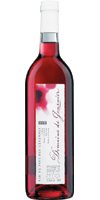

The only rosé I've had this season is also the only rosé I've bought multiple bottles of. Easily pleased? Perhaps I am. A couple of Domaine de Gournier Vin de Pays de l'Uzège 2005 won't let you down when you and three friends are on a summer holiday picnic...
...unless you plan on remembering your hat.
Posted by Marcus | Wednesday, June 28, 2006 0 comments
20060627
Why some wine quenches a thirst but still leaves you hungry: Benjamin Brunel Rasteau 2003
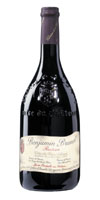
Rhône Valley wines from the 2003 vintage encourage a pronounced divide among critics. Incredible summer-long heat made for atypical results -- whether those results are lauded or shunned depends on which expert you consult.
The wine aficionados who favour big fruity expressions, concentrated or heavily extracted wines seem to take to 2003 yields like a duck does to water. Others who are let down by meek acidity often claim the vintage's results favour an uninteresting, if not entirely flat, product.
I find myself among the latter group of voices. And the Benjamin Brunel Rasteau Côtes du Rhône-Villages 2003 is a case in point. It has a lovely caramel nose, but you can sense immediately that it is hot. On the palate, the fruit isn't too baked to render admirable shades of dark cherry, blackberry and cassis. Still, it all seems a little too cooked for my tastes. The unique wilted and twisted bottle for this 2003 concoction has never seemed more characteristic.
But then, I do not tend to drink and appreciate wine on its own. Generally, when taken with food, wines of crisp acidity fare much better than those of low-level acid. So that tells you a bit about where I'm coming from, i.e. not a big fan of Grenache much. A hearty meat pie, a salad, a cuisse de canard laquée with flageolets in a tomato and veal demi-glace... none of it especially sings when paired up with this burly Rhône. It is particularly unattractive when next to cheese like Gruyère -- it's too fruity and heady for that. It's not even something to drink when munching on fresh artisanal bread.
LOOKING AHEAD: AVERAGE CONDITIONS, BETTER VINTAGE?
Love it or hate it, it's now the time to move past the 2003s and look towards the 2004s. Benjamin Brunel 2004 has been available for purchase for some time now and just looking at the percentage of alcohol on the bottle label, you can guess that it's a better example of the frequently congenial Southern Rhône style.
After a wet and disastrous 2002 vintage and the heatwave of the 2003 season, almost everyone agrees with Thierry Usseglio, prominent Châteauneuf-du-Pape producer when he says that 2004 is "almost a normal year whose wines will be much more interesting than the 2003s".
Châteauneuf-du-Pape, France. 13.5%
Posted by Marcus | Tuesday, June 27, 2006 3 comments
20060626
The heat is off

A welcome addition to any wine enthusiast's un-air-conditioned home! Yes, my wine fridge is finally here.

It looks like an extremely hefty microwave oven. It's about the size of one of those industrial ones they use in fast-food kitchens or the old-fashioned kind that used to pervade atop the Whirlpool range on The Price Is Right. Of course the marked difference is on the inside... 
Barker's Beauties never opened up any home appliance to reveal 9 + 2 bottles in sweet 13-degree slumber! (I took out the eleventh bottle to better capture the inside of the fridge, but if you want to see what I'm packing in there, check online at manageyourcellar.com, the free cellar management software I use.) I've been calling these units "wine fridges", but the manufacturer Chambrer calls them wine cellars. Installing it just ahead of the crest of summer's first heatwave, I can see why their term is more appropriate: You won't feel a gust of cool air coming out of this thing. Its lowest setting only seven degrees Celsius. It took a long time -- like an entire day -- to chill things down to cellar temps from the normal summer temperature of my apartment. But once it reached the target temp, a small motor which requires the same amount of power as a 100-Watt lightbulb seems to maintain levels quite easily. So far so good. My sister and her boyfriend set up the stand-up floor model at Christmas and I haven't heard any complaints from them.
I've been calling these units "wine fridges", but the manufacturer Chambrer calls them wine cellars. Installing it just ahead of the crest of summer's first heatwave, I can see why their term is more appropriate: You won't feel a gust of cool air coming out of this thing. Its lowest setting only seven degrees Celsius. It took a long time -- like an entire day -- to chill things down to cellar temps from the normal summer temperature of my apartment. But once it reached the target temp, a small motor which requires the same amount of power as a 100-Watt lightbulb seems to maintain levels quite easily. So far so good. My sister and her boyfriend set up the stand-up floor model at Christmas and I haven't heard any complaints from them.
Another thing that really made me realize this is more of a storage device than a refrigerator is the fact that I really still require my regular refrigerator to serve wines properly, especially in the summer. Even if you remove a special wine from storage for dinner, it's going to heat up fast on a hot Montreal night. This means I'm likely to slide the bottle inside the fridge door for chilling until my glass needs refilling.
When you're serving a lot of people, heat between pours may not become an issue. In my sauna-like surroundings, there's a complex formula involving speed of wine guzzling and ambient room temperature that is just beyond my reach so I just take a trial-and-error approach. In any case, party wines are less likely to be among those sacred few bottles you've got cellared away in perfect storage conditions. (To jump to a) Conclusion: Perhaps a wine cellar for storage buffered by another wine cellar for serving wouldn't be such a bad idea.
Posted by Marcus | Monday, June 26, 2006 0 comments
20060623
What's a little prep work for such a food-friendly wine?
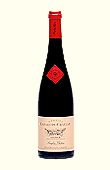
Domaine Langlois-Château St-Florent Saumur 2004 has heady meandering aromas and a deep dark hue suggesting concentrated, heavily-extracted Cabernet Franc grapes. On the palate this wine is a bit tight and needs time in the decanter or better yet several hours uncorked in the fridge. The tannins will loosen and become supple over time and it was on the second day that this wine opened up.
THE WINE PREP
With time and chilling (serve anywhere below 16 degrees Celsius, I would say), this wine is winning. It is Cabernet Franc through and through: slightly weedy upon opening but that gives way to intense and profound fruit -- blackberries and black cherry. Plus an earthiness develops which lends a palatable herbal character to this wine. Quite a nice specimen if you like this kind of varietal.
THE FOOD PREP
I paired it with tourtiere and I would certainly serve it alongside similar food in the future. St-Florent Saumur from Langlois-Château stands up to the rich and pungent buttery pie crust of the meat pie. And it complements the rooty spices like cinnamon, clove and nutmeg that are found in flavouring to the beef and potato filling. Broccoli, seasoned heavily with ground savoury and sea salt makes a good and quick-to-fix side. Add a couple of grape tomatoes to the mix and your dinner plate is as full and as balanced as this well-made bottle of wine.
Just remember when you are preparing the food that this wine needs some preparation too. Decant it well in advance. You really can't do it too early. Once that's out of the way you can concentrate on your other prep work.
St-Hilaire-St-Florent, Maine & Loire, France. 13.5%
Posted by Marcus | Friday, June 23, 2006 0 comments
20060622
Night flight
The following crib notes are gathered from around the Internet and beyond for my imminently approaching birthday dinner.
Vineland Estates Dry Riesling 1994
L'entrée
The most memorable property along the Niagara wine route is none other than Vineland Estates Winery. Some say it’s because of its location—on the bench of the Niagara palisade, overlooking rolling hills and Lake Ontario. But there’s more to Vineland than just a pretty view. Its premium wines and world-class restaurant are what captured our attention.
Riesling has become the hallmark of the property, and a number of vintages have snagged top honors at championships not only in Canada, but also in France, Italy, England, and the United States. These changes are due to the efforts of general manager Allan Schmidt and of Schmidt’s brother Brian, Vineland’s chief winemaker.
Michel Phaneuf recommends Riesling with seafood, fish, fresh vegetables. Local pairings where terroir and dish come together are encouraged as well.
Well-aged Riesling will gain a colour of goldish yellow with a nose of petrol. 2006 marks the end of this varietal's astonishing design life. Konrad Ejbich rated it among the best of Ontario's current Rieslings and warned that it should be opened soon as it is beginning its decline.
Château Montauriol Mon Aureolus 2001
Plat principal
Composed of Négrette 50%, Cabernet Sauvignon 25%, Syrah 25%. The wine has a brilliant and deep ruby red colour. The nose is strong, velvety with a nuance of ripe red fruits. Elegant touch of blackcurrant and violet. Equally there are spicy undertones of « garrigue ».
On the palate the wine is robust, harmonious and long with nice touch of truffle and wood. The tannins of this wine are soft with a smoothness which is a characteristic of the local grape variety, the Négrette.
It is recommended to serve with red meats, game and hard cheese at a temperature of 17 to 19 °C. This wine is to be drunk within 2 to 10 years.
A favourite birthday wine. This vintage was a hit last year at La Colombe.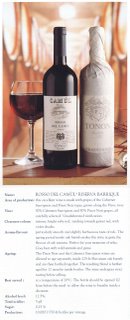
Tonon Rossi del Camul 2001
Plat/Fromages
Suggested by the Caveman, sommelier at L'Eau à la Bouche in Ste-Adèle. Click image at left for details on this wine.
[Understudy for reds: Giordano Da Uve Il Vinré 2003]
Domaine Bellegarde Jurançon sec Cuvée tradition Moelleux 2002
Dessert
Silt clay soils with a lot of pebbles left by torrent. 35% Petit Manseng, 65% Gros Manseng.
Individually sorted and handpicked harvest of fully matured grapes in order to obtain a typical Jurançon. Vinification and ageing in stainless steel vats for Gros Manseng, and oak barrels for Petit Manseng.
Thanks to blending the two grape varieties, the wine gets lively and fresh notes of matured citrus fruits from Gros Manseng, and refinement and maturity from Petit Manseng, which gives the wine all its roundness.
A perfect aperitif and wonderful dessert wine.
Lemaistre Grenache Riche 2002
Extra bottle, should it be needed ("for the table")
No it's not Port, but when served at the end of a long rich meal it feels like a light digestible version of it.
Check back and I'll let you know how it all goes down.
Posted by Marcus | Thursday, June 22, 2006 1 comments
20060621
Meat & potatoes & Shiraz-Cabernet: Domaine du Lys 2004
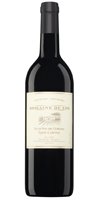
I decanted and served this $10 bargain bottle with brazenly rustic "comfort food" -- a densely flavoured mash of potatoes, garlic cloves, herbes de provence and cream (enough to get the mashed potatoes to a glue-like stiff but smooth texture.
The whole dinner shebang, including the wine can work out to less $15. That works out to about $7 per person, which is awesome. Here's how I did it:
- picked up the cheapest pork chops I could find: sprawled under the oven broiler in a thrown-together mixture of soy sauce, sliced garlic and cracked peppercorns. Three minutes a side. Then let the chops rest in some lemon juice, speckled with its own lemon rind and chopped fresh sage (this is a simple Jacques Pépin recipe).
- grabbed some broccoli, chopped it into florets, tossed them in boiling water for two minutes, drained and then momentarily reintroduced them back into the same pan -- this time laced with a thin layer of olive oil, ground savoury and garlic, yes more garlic.
- mashed up the taters with dry herbs, some more of that garlic and a little cream for cooking
Domaine du Lys Syrah-Cabernet 2004 is not fine wine, but it is good wine. Goes great with what I made: not fine cuisine but damn good cooking. Shazam! Or however that thing goes.
If you are meat and potatoes eater, I think that little beats a Syrah/Shiraz-Cabernet to drink with dinner. I suggest opening Domaine du Lys as soon as you enter the kitchen so it can stand in a wide-bottomed carafe while you prepare, cook and present the food you are making for dinner.
Not as opulent or complex as my other favourite Syrah-Cabernet blends, Domaine du Lys certainly gets the job done. And in 2004, its youthful juices benefit from recorking/reserving so you've got ideas in the bag already for the next night, providing you have leftovers.
Blauzac, France. 13%
Posted by Marcus | Wednesday, June 21, 2006 2 comments
20060620
Wedding pictures
Local wines dotted the tables of my friends' wedding over the weekend. Colio Estate Wines makes a very pleasant blend of Vidal and Riesling and bottles it under their CE Proprietor's Selection label. Whether you asked for the delicious salmon or the stuffed chicken, it was a fine match, much like the happy couple.
More pictures forthcoming! For now, you can spot more of the wine that's peeking out from the photo of these gorgeous revelers by visiting Colio's online order form.
On the bottle neck, Colio proclaims their 25th anniversary of harvesting and matching wine grape varieties like Vidal and Riesling to create great blends. A nice idea on Cathy and Tyler's big day...
Johanna and I got ideas ready for a wedding toast during dinner. Don't hold your breath for a podcast.
PHOTOS: GORDON MARTIN
Posted by Marcus | Tuesday, June 20, 2006 0 comments
20060616
Castelão, Camarate, Touriga Nacional, Touriga Franca, Tinta Roriz: Palha-Cañas 2004
Or, Watch carefully as a five-grape blend from Portugal devours your rib-eye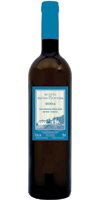
I heart Portuguese wines and I bristle when people label them as too rough, overly tannic or inelegant. Yet I can't defend this mid-priced Portuguese bottle called Palha-Cañas as it really is quite coarse.
This is an acidic and alcoholic blend. After nearly an hour in a decanter, I conclude that this wine is not the harmonious product that many of my favourite Portuguese red wines are. Not that I'm looking for finesse here -- Portuguese wines often feature a style that is rustic but charming in its own way.
ELUSIVE CHARMS, TIME-CONSUMING PAIRINGS
Palha-Cañas Estremadura 2004 has a heady nose and pours out into your glass in a thick purple stream. Strong figgy fruit does shoulder its way through on the palate. The flavour is so pronounced it is half way to Port wine.
Given time to mellow, this still young but big red makes an acceptable match for a rib-eye steak done in a rich red-wine-and-shallot sauce. Add lots of thyme and tarragon too -- there is no amount of savoury relish that will outdo this Portuguese force.
But in the end, the Palha-Cañas is still astringent after several days and a lengthy decanting. The tannins are still sharp and drying on the finish though aeration does seem to lead to better balance and a bearable finish. Was it worth such a long wait? At just over $15 a bottle, I would say no.
Casa Santos Lima, Quinta da Boavista, Portugal. 14%
Posted by Marcus | Friday, June 16, 2006 0 comments
20060614
WBW #22 Lite reds: Château Cahuzac 2003
Ultra zoom and the focusing in on a very very light 12%
For this month's WBW, which is being hosted wonderfully by Winecast, drinkers are asked to keep the alcohol to a minimum. Find a red wine that has no more than 12.5% and write about the impressions that this "once-traditional" level of alcohol has on wine and its flavour.
I think this is the most brilliant topic yet for this event. In many cases, it forces us to look beyond our usual everyday wines, which is always a good thing. But even better than that, Tim from Winecast is encouraging us to grapple with the idea that wine is more than the sum of its parts. Because, you see, alcohol does not have a taste. Yet no one can doubt its impact on wine when you drink the stuff.
So while you cannot taste alcohol itself, its proportions very much do make wine taste differently. There's a sensation or a bigness lent to a wine with high alcohol that you can definitely sense.
In a total coincidence, I tasted Casa Lapostolle's Sauvignon Blanc as apertif to the WBW festivites last night.  My friends and I were preparing dinner and decanting my low-alcohol red, when it hit me: a whopping 14.5% white wine attack. This is an interesting wine, to be sure, but Sauvignon cannot support that kind of heat in the bottle. Despite all its flair and craft, Casa Lapostolle Sauvignon Blanc 2005 tastes too much like a distilled bar drink for my liking. (Did I mention that the Casa is actually run by Grand Marnier?)
My friends and I were preparing dinner and decanting my low-alcohol red, when it hit me: a whopping 14.5% white wine attack. This is an interesting wine, to be sure, but Sauvignon cannot support that kind of heat in the bottle. Despite all its flair and craft, Casa Lapostolle Sauvignon Blanc 2005 tastes too much like a distilled bar drink for my liking. (Did I mention that the Casa is actually run by Grand Marnier?)
But then, I am probably the least likely of all the bloggers in the WBW 22 sphere to drink 14%-plus wines on a regular basis. I opt primarily for Old World wines, and often lighter red ones, so it is not uncommon to see 12.5% reds populating the pages of Weingolb. A brief foray down my sidebar index reveals many of these "lite reds", and even a delightful French vin de pays with only 12% alcohol to boot.
How low could I go, I wondered, as I went off to purchase a bottle for today's event? Finding a 11.5% red was not too difficult. Both Marcillac and Côtes du Forez, which are French regional wines, are in that range. Since I didn't have a firm grip on the style in which they are made or the from which grapes they are blended, I decided against them. I didn't want to judge the success or failure of low alcohol by holding up for scrutiny a wine for which I had no comfortable point of reference.
So I found a wine called Château Cahuzac L'Authentique from food-friendly Fronton, a town north of Toulouse in southwest France. This is the area from which my absolute favourite bargain red originates: Le Montauriol tends to have about 13% in most of its vintages, but I never gave the number much thought. Until now, that is. I wondered whether lowering that percentage would in turn lower my opinion of this fresh and deft style of wine. Would the 12% value in my newly found Frontonnais infringe on enjoyment?
Until now, that is. I wondered whether lowering that percentage would in turn lower my opinion of this fresh and deft style of wine. Would the 12% value in my newly found Frontonnais infringe on enjoyment?
The 2003 Château Cahuzac Côtes-du-Frontonnais has nice ripened and mûr jam flavours. It is harmonious and smartly punctuated by a slightly bitter finish. Like the bottle says, warms tones of licorice and pepper are delivered. Nice balance, faint nose, not tremendously pigmented or extracted but not seemingly lacking anything. Pleasing all around. But I didn't find that this was the case at all upon my first tasting. I had just come off the searingly hot Lapostolle, and after clearing my palate with some bread, I found that this little red was sapped and dreary. It was like a faint echo of a wine, as if it had been watered down and painted on with fruit.
MORAL OF THE STORY: ARRANGE TASTINGS BY VINTAGE, BODY, SWEETNESS, AND... LEVEL OF ALCOHOL
Later, long after dinner was served, I returned to the wine. It wasn't faint or treacly at all. It even has what I would call medium body -- just less of it than the preceding white, which was whopping. And perhaps that's the greatest lesson of all in WBW 22: minimal alcohol is not necessarily equated with light body. And alcohol does not carry balance or concentration in a wine. It is more elusive than that. Yet it is there to jump out and bite you. Especially if your flight moves from a 14.5% white wine to a 12% red!
Tarn et Garonne, France. 12%
Posted by Marcus | Wednesday, June 14, 2006 1 comments
20060612
Rockets to Mercurey: Domaine Michel Juillot 2003
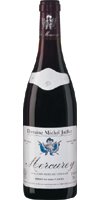

Like the planet Mercury, wine from the Côte-Chalonnaise town of Mercurey is predominantly red (90% of bottles produced there is red wine, reports Jancis Robinson). Since Mercurey is nestled in the heart of Burgundy, red means Pinot Noir. And since Mercurey carries with it a lesser-known Burgundian appellation, red also means bargain. I got the sophisticated cuvée pictured above on sale for a hair over $20.
Domaine Michel Juillot Mercurey 2003 may not be as solid or firm as your average Côte D'Or product. At least that is what the experts say -- you have to be fairly flush to dabble with the cream of the Burgundian crop. So if, like me, you can only occasionally afford a Mercurey such as this one, you will do well in treating yourself to a good, reasonably priced Old World Pinot Noir.
The 2003 Juillot has smoky and earthy notes which are characteristics of the Pinot Noir grape. On the palate, there is big, bold but elegantly nuanced cherry fruit. I tend to think of some Mercureys as northern takes on Rhône wines -- from the central French valley below Beaujolais and just south of here -- with their typically luscious cherry fruit. They are totally different grape varieties but both possess a similar intensity of cherry fruit.
You are encouraged to serve this fruit-filled Mercurey at 14 degrees. In the summertime, that means sticking it in the fridge a good quarter-hour before you are ready to serve it. Since I would recommend decanting the entire bottle to let the wine open up, obtaining that lightly chilled temperature is easy as pie. Just stick your carafe in the fridge as you get out your ingredients for a dinner.
WHAT TO TAKE OUT OF YOUR REFRIGERATOR WHEN YOU PUT IN YOUR WINE
On the subject of food pairings, the bottle label says this wine matches red or white meats, as well as cheeses. If that seems too vague and general, I'll widen the playing field even further. How about a salad made up of whatever you have on hand? Throw it all in the salad bowl and toss with a vinaigrette. One restriction: make whatever you want just as long as you're working with arugula greens, or rockets, as they are sometimes known. Why arugula?
The mushroom is supposed to be a legendary pairing for Pinot Noir. Those deep and foresty tones in rich mushrooms like truffles, chanterelles or black trumpets are echoed in the wine. Sounds great indeed but expensive wine and expensive ingredients... you are going to have eat again this week so don't break the bank on one meal. Instead of mushroom delicacies, turn to the nutty, rich and pungent flavours of arugula to live up to your Mercurey.
A salade composée centred around the hearty arugula leaf is not only cheap but a cinch to prepare. There are no rules really: hard boil some eggs and slice them up, rinse some canned beans and coat them with herbs and oil, dress up some cold leftover boiled potatoes or whatever you've got. Mound the various items around the edges of your tossed rockets and feast.
Mercurey, France. 13%
Posted by Marcus | Monday, June 12, 2006 0 comments
20060609
Goodbye to a great wine (and hello to another): René-Noël Legrand Les Terrages 2001 (and Renzo Masi Erta e China 2003)
 René-Noël Legrand makes a Cabernet in the Loire Valley called Les Terrages. If you can find it, especially the 2001 or 2002 vintages, don't hesitate to purchase as many bottles as you can. If you like to eat when you drink wine you are guaranteed to fall in love with it.
René-Noël Legrand makes a Cabernet in the Loire Valley called Les Terrages. If you can find it, especially the 2001 or 2002 vintages, don't hesitate to purchase as many bottles as you can. If you like to eat when you drink wine you are guaranteed to fall in love with it.
I first fell under its spell over a year ago. Now all I've got is a memory and this post since I now have no bottles left. At one point, I stocked more of this wine that any other. I once rode a bus 75 minutes each way to haul away nine bottles of the stuff from distant liquor outposts. I was likely listening to PJ Harvey while doing it.
After five years, the René-Noël Legrand Saumur-Champigny Les Terrages 2001 is beginning to reveal hints of earth and wet slate that I didn't pick up before. In fact, in 2006, this bottle is showing a perfect balance between what I call fruit and 'shrooms.
It has a violet nose which comes across on the palate as well. The wine is a classic expression of Cabernet Franc: slightly vegetal but spicy, making it less austere than a comparable Bordeaux interpretation.
Locally, this wine has disappeared. For a while only the hotter and less appealing 2003 vintage remained. Presently nothing at all is available from René-Noël Legrand at the SAQ. Which is too bad because I think it is a strong candidate for most food-friendly wine that I've ever had.
Varrains, France. 12.5%
Don't go starving when you can't find a wonderful bistro-designed wine like Les Terrages. Go for the Renzo Masi Erta e China, which in its 2003 version is a stunningly full-bodied Tuscan red. Like the above hard-to-find wine, this Sangiovese-Cabernet Sauvignon blend is not available in Ontario or Quebec. But you can taste this private import by the glass or by the bottle at Brunoise. That's what we did last night during a fantastic evening of food and wine surprises.
I have not been a fan of The New York Times's Frank Bruni since he glorified the drive-thru window on his blog, so I was happy to find out that Brunoise does not mean possessing Frank Bruni qualities. Rather the term is a method of food preparation, usually for soups, involving diced carrots, celery and sometimes zucchini.
And it's a really great name for this restaurant since, like its culinary namesake, Brunoise seasons its food with other food. What I mean is that instead of the usual herbs and spices (the only herb I identified over four courses was a smattering of chives in the amuse-gueules), you get highly flavoured and brilliantly prepared savoury bits: fruit, nuts, cheese, vegetable purées and reductions, all knowingly integrated into each dish. This amplifies the mostly French fare in a really nice way. Check out their menu.
It's not quite Asian but Brunoise style certainly packs a lot of umami.
Posted by Marcus | Friday, June 09, 2006 3 comments
20060607
The legendary Meatloaf Sandwich, Piemonte-style (with Terre da Vino La Luna E I Faló & Michele Chiarlo Le Orme 2003)


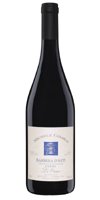
I missed my friend Alex's birthday on the weekend. I was out of town. I was out of town last year during this period too. So this year I thought I would pick up something nice while away and make sure that I made Alex and a couple of our friends dinner before I left.
Then I thought I would publish an entry about it all on her birthday. If I couldn't be at her party in person, Doktor Weingolb could at least manage a shout-out during the festivities.
Well, two out of three ain't bad. This post is belated. Happy birthday Alex!
For you Alex, a souvenir of my travels to the Ontario Fruit Belt is on its way: delicious and pure black currant preserves (well what do you expect from a foodie?) harvested from the Moss Berry Farm in Embro, Ontario (which, being near Woodstock, is a bit farflung from the fruit belt -- the beginning of June is still too early for good Niagara tenderfruit).
I hope you will enjoy it and this retrospective of our Italian-themed meal in your honour...
(Because Alex is Greek, Northern Italy was the mode of the evening, both in terms of food and wine: A Venetian Maculan Pino & Toi to get our juices flowing and then Barbera-based Piemonte wine for an authentic match to the main course, which was a scrumptiously easy meatloaf, seasoned with fennel and nutmeg.)
A Meatloaf, dressed to impress (even its leftovers!)
So as to not insult your guests by serving them ground meat shaped into a log by your bare hands, insert hard-boiled eggs into the centre of the meat mixture before baking. Meatloaf is such an imprecise and forgiving dish that adding the eggs lifts the low standards of the creation and makes for a nice visual feast too. When you slice into it later, your guests will have "I can't believe my eyes" looks on their faces and then follow it up by blurting out questions like "How did you do that?" and "Where did the eggshells go?"
In another twist on the standard, cook the loaf as per tradition on the stovetop in a Dutch oven or other large, heavy, covered pan, which should already be lined with browned onions and carrots -- a kind of Italian mirepoix. Slow-cooking your meatloaf over low heat helps generate a nice gravy that you can serve with it. To determine doneness, use a meat thermometer after you've turned the loaf a few times while it is simmering.
Grilled zucchini and tomatoes are nice garnishes to this dish because they ooze Italiano. While they may be a nice pairing, they're not nearly as essential as celery root (celeriac or céleri rave). When mashed with a little butter and some cream, this celery side will want to cozy right up to the meatloaf.
Except for the zucchini, I served these dishes hot, but they do not need to be. In fact, at room temperature this food really sings. Which means that you should make big batches while you're in the kitchen to ensure you have leftovers when you are done. It's a great idea for summer since it offers a respite from the heat.
WHAT'S "THE ALEXANDRA"? An even better reason to let your Italian creations cool a bit is so you can make what I call the "Alexandra" -- an incredibly fantastic meatloaf sandwich. What's great about an Alexandra is its meatiness -- the meatloaf is sliced like bread to go on either side of your leftover celery root mash, which, playing the usual role of the meat, is on the inside of the sandwich you've formed. Who says the best part of a sandwich has to go in the middle? It ain't called meatloaf for nothing. Take out your best bread knife and slice away. If you do it right the finished sandwich almost looks like egg salad on rye. Though the taste is entirely something else!
An even better reason to let your Italian creations cool a bit is so you can make what I call the "Alexandra" -- an incredibly fantastic meatloaf sandwich. What's great about an Alexandra is its meatiness -- the meatloaf is sliced like bread to go on either side of your leftover celery root mash, which, playing the usual role of the meat, is on the inside of the sandwich you've formed. Who says the best part of a sandwich has to go in the middle? It ain't called meatloaf for nothing. Take out your best bread knife and slice away. If you do it right the finished sandwich almost looks like egg salad on rye. Though the taste is entirely something else!
Yet another good reason for leftovers is better gravy. Meat juices, when they sit around refrigerated for a few days, intensify in flavour and thicken in consistency. The extra time also builds up your appetite, or at least I find it does. Then when you are desperate, sprinkle in a little more nutmeg to taste and some sherry. Boil it down to reduce the sauce further. The result is like liquid gold. CANNOT LEAVE THE CANOLI ALONE
CANNOT LEAVE THE CANOLI ALONE
To cap off Alex and the gang's Italian menu, we had ricotta-filled canolis. Summer comfort food is best followed by more comfort food and these fine pastries, when done right, are a perfect way to end the meal. I'm not sure whether these Italian canoli delicacies originate in the north of Italy or not. I can say for sure where they are going though. To the stomach, via my mouth.
WHAT ABOUT BARBERA?
Some tasting notes on the wines that went the dinner. Like Monica, Barbera is a lovely red Italian grape named for a woman. Also like Monica, Barbera, especially Barbera D'Asti, makes for a tremendously food-friendly, fruit-filled wine. Barberas are usually more elegant and less rustic than other regional Italian grapes. Notes of chocolate can bolster fruit flavours and strong acidity punctuates every mouthful. I found that it married particularly well with our rich and flavourful dinner.
Two expressions of Barbera, both from the same strong 2003 vintage in the Asti region of Piemonte are affordable and recommendable:
La Luna E I Faló from Terre da Vino is an oaked and dense red with noticeable chocolate notes. Le Orme by Michele Chiarlo is zestier, lighter, and more simple in style.
Nizza Monferrato, Barolo, Italia, 14%. Calamandrana, Italia. 13%
Posted by Marcus | Wednesday, June 07, 2006 0 comments


